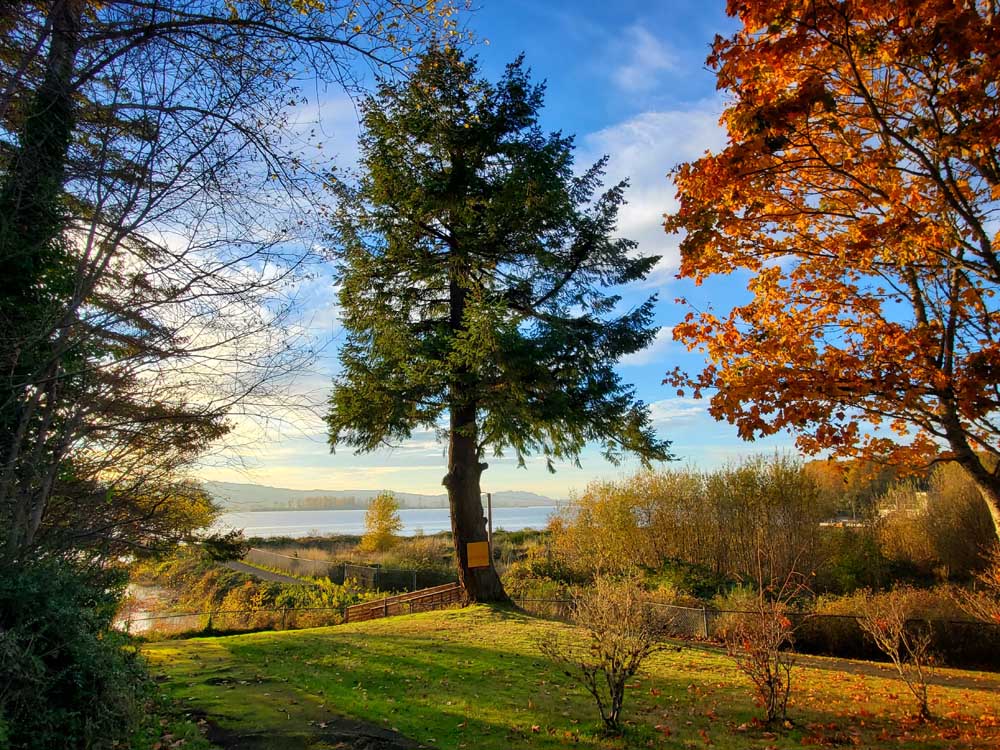Early ‘Christmas miracle’ saves old-growth Douglas fir
Published 7:34 am Thursday, December 26, 2024

- Cathlamet’s Strong Park Fir, which was to be cut down as part of an otherwise-popular riverfront park redevelopment, has apparently been saved after public objections were raised.
CATHLAMET — Thirty-six million trees are cut down in the U.S. every year. Will anyone — anywhere — object if one more tree is cut down? How about anyone from this mostly pro-logging town? If the tree in question is the 230-year-old Strong Park Fir, many eventually objected.
Trending
For nearly six months, controversy and heated debates regarding this tree’s removal has become the focal point of contentious community discourse. Advocates for the tree questioned the public process and objected to the city’s plans to cut it down. Ultimately, their advocacy created an early “Christmas miracle” for the Strong Park Tree. On Dec. 17, those who planned to cut this iconic tree granted it a permanent stay of execution. They are now offering to work with anyone who wants to join them in protecting and preserving the fir for as long as it lives.
Mayor David Olsen made clear the city’s commitment to the fir in a Dec. 17 email. “The council and the mayor have reached consensus to save the tree by trying to build an ADA path around it, or at an alternate location.”
‘Thank you from the bottom of my heart for identifying that tree as significant, even when our own cultural report failed to do so. That’s a failure of the cultural report — just as it was a failure of town governance to not be transparent about the actions of October.’
Trending
David Olsen, Cathlamet mayor
During a Town Council meeting the previous night, Olsen directly addressed advocates for the tree: “If we achieve the community’s ardent desire, which is to save the tree and build a waterfront park, you should be commended, congratulated and thanked. … Thank you from the bottom of my heart for identifying that tree as significant, even when our own cultural report failed to do so. That’s a failure of the cultural report — just as it was a failure of town governance to not be transparent about the actions of October. I apologize to you for that.”
Fir advocates
No one advocated for the Strong Park Fir’s survival more than Megan Blackburn Friend. The town’s new commitment to preserving and protecting the tree has left her “cautiously optimistic.” Related to the mayor’s saying, “…there have been hostility and threats directed against the Mayor and Council members, amplified and echoed on social media by the advocates for the tree,” Blackburn Friend commented, “I’ve never seen or condoned any violent comments on any Facebook posts related to the tree.”
The first inkling Blackburn Friend had of the city’s plan to remove the fir was on July 4, 2024 when the following line appeared at the very end of the Cathlamet Town Council report printed in the Wahkiakum County Eagle: “Lastly, the Douglas fir in Strong Park to be removed for safety issues.” This notice inspired Blackburn Friend and other members of the Cathlamet community to make the city aware of their concerns and objections to the tree’s removal.
The Strong Park Fir grows on property owned by the Wahkiakum County Historical Society (WCHS). After learning of the city’s plan to cut down the tree, WCHS’ executive board asserted that the city needed WCHS’s permission to do so. The city responded that its easement on WCHS property and associated liabilities already gave the city the right to remove the tree.
According to Mayor Olsen, “…design for the Strong Park entrance to the new Waterfront Park has presumed removal of the tree (along with many other prep items) for more than a year, has been shown on design maps and discussed publicly in workshops and the planning process. This is because the tree remains a significant barrier to affordable construction of an ADA [Americans with Disabilities Act] pathway into the new park, which is a condition of a $500,000 state grant awarded to the Town to build the park.”
WCHS did not agree. It retained an attorney to represent it on this matter. Olsen is a former president of WCHS.
“The entire board is against the removal of any trees,” said the executive board of WCHS in their Aug. 5 letter to the city. ”Furthermore, we see nothing in the agreement [the county’s easement of Strong Park] that gives the town the right to remove trees from our property.”
WCHS invited the mayor and town council to its Sept. 9, 2024 meeting “to negotiate a reasonable alternative.” As of the writing of this story, there have yet to be any meetings between the WCHS executive board and the city council regarding the Strong Park Fir.
Executive session
On Oct 21, the city appears to have addressed WCHS’s notice and public objections in an executive session. It is currently only known to those participating in that executive session exactly what was discussed. Based on subsequent events, it appears a final solution of the Strong Park Fir issue was privately developed in this session. Allegedly, the city developed a plan at this executive session to hire a local tree-feller to remove the Strong Park fir, despite overwhelming public opposition, without further notification and in defiance of WCHS’s assertion that the town had no right to cut trees down on WCHS property.
“If I hadn’t left a message on a friend’s phone to invite him to the WCHS’s annual meeting, that tree would be gone forever,” said David Whitney, WCHS vice president. “When my friend called back on Nov. 6, the first thing out of his mouth was, ‘I’m so sorry we didn’t get that tree cut down last weekend.’ I was shocked and told him in no uncertain terms that the WCHS did not want the tree cut down.” (Whitney’s friend is not named in this article because “he is not interested in having his name mentioned.”)
Shortly after learning of the city’s plans to remove the fir without WCHS’s permission, WCHS put a chain link fence around the tree and posted a no-trespassing sign on it.
“It’s a miracle this tree exists at all.” Whitney said. “It is growing on a surface that is little more than basalt. In the 1990s, a few years after the asphalt path was built over the tree’s roots, it was topped to remove damaged and dead wood. The tree recovered and is currently in good health.”
WCHS’s executive board sent a letter to the city of Cathlamat on Nov. 27, which said, “The fir tree at Strong Park is on property owned by WCHS. It is museum property, and its removal without our explicit written consent is unauthorized and constitutes trespass. … We expect the Town to respect property rights and act in accordance with the law.”
Town changes course
In response to growing community passion and input on this issue, Cathlamet released a public notice on Dec. 9 that granted the Strong park Douglas a stay of execution. In addition to sparing the tree, the notice said, “…the Town is exploring, with our engineering firm, options that might preserve the tree and allow the Town to install an ADA compliant path.”
Postponement of the tree’s removal and revelations of explorations of non-removal options were met mostly with skepticism from advocates of the Strong Park Fir. The reprieve may be temporary.
The mayor contends, “Removal of the tree was included in published park design plans and presumed to be necessary in order to construct a required ADA pathway. The Washington State Recreation & Conservation Office through its Grant Manager has worked with us every step of the way and expressed no problem with this solution to implementing an ADA path, nor did the Cultural Resources Report identify any problem with our plans.”
Proponents of preserving the Strong Park Fir expressed concern that the same people and methods that allegedly led to the city planning to secretly cut down the tree down without its owner’s permission could ultimately lead to it being cut down later without proper consideration of its significance.
While there have been no direct talks between the city council and the WCHS, Mayor Olsen informed the Observer, “The Town Attorney has regularly communicated with the identified attorney for WCHS, including as recently as today, [Dec. 17], when the Town attorney notified the WCHS attorney that Town Public Works will cooperate in protecting the tree, including placing bark dust around it if asked. We have also requested further discussion with WCHS regarding a commitment [forwarded by advocates] that WCHS might share with the Town a portion of the increased cost of ADA build options that protect the tree.”
Waterfront Park
It was the city’s ongoing efforts to create its Waterfront Park that put the fir in jeopardy. The $1.3 million Waterfront Park project has enjoyed broad community support. Olsen is proud to promote this project and what the city hopes to achieve with it.
“The Cathlamet Waterfront Park development has enjoyed virtually unanimous community support here for more than ten years. It took four years (and two attempts) to obtain grant approval from the state,” Olsen said. The site is one of the only remaining substantial pieces of publicly owned riverfront property on the Lower Columbia River. Our vision remains to preserve this priceless tract for Cathlamet and future generations, including citizens and visitors to our beautiful and historic community.”
The Waterfront Park restoration and development project intends to transform the former site of the town’s sewer lagoons into a scenic and accessible seven-acre recreational space for visitors to relax and experience the beauty of the Columbia River.
Wahkiakum County was once covered by one of the greatest and most productive forests ever seen on Earth. These forests held Douglas fir, Sitka spruce, western red-cedar, western hemlock, and other huge conifers. While it is not part of these great forests, the Strong Park fir is a legacy tree. It’s older and larger than most trees. It stood when the Wahkiakum and Kathlamet people lived on the shores of the Colombia below it. The Lewis and Clark Expedition passed it coming and going. For over several hundred years it grew to stand over Cathlamet and the Columbia River.
This fir could remain a silent sentinel over Strong Park, its historical museum and soon to be developed Columbia River Waterfront Park long after all who fought for its continued survival have passed on.









